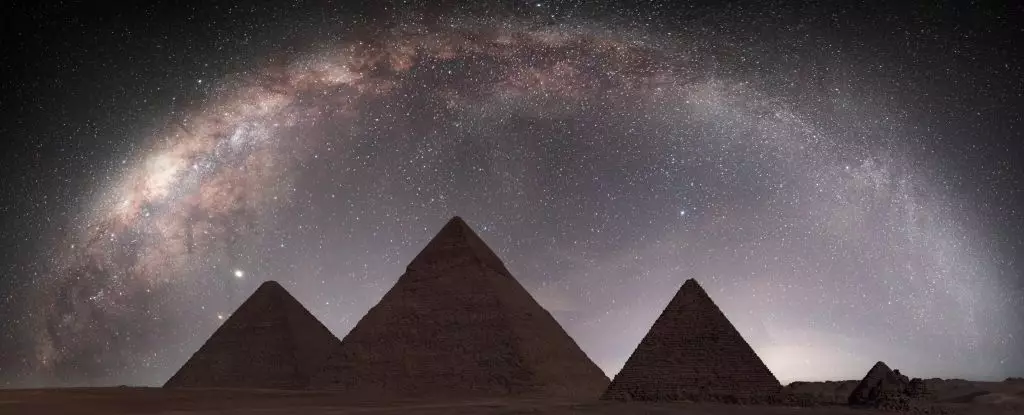The intersection of art, spirituality, and science takes us on an incredible journey spanning thousands of years back to ancient Egypt. Recent research has revealed that depictions of the goddess Nut, associated with the sky, may represent a sophisticated understanding of our galaxy, the Milky Way. Similarly, these portrayals invite us to explore not only an artistic legacy but also the ways that ancient peoples interpreted the cosmos. This intersection of ancient belief and modern astrophysics reveals an extraordinary depth of knowledge that ancient Egyptians might have possessed.
Or Graur, an astrophysicist from the University of Portsmouth, conducted an exhaustive study of hundreds of Egyptian coffins, drawing intriguing connections between ancient art and modern cosmic phenomena. His findings indicate that the representations of Nut are not mere artistic expressions but may encapsulate a conceptualization of the Milky Way’s visible plane, revealing how ancient cultures sought to understand their universe.
The Goddess Nut: More Than Just a Deity
Nut is not just another figure from the pantheon of Egyptian gods; she plays a pivotal role in their cosmology. Often depicted as a slender, naked woman adorned with stars, her body stretches protectively over those on Earth, symbolizing the sky itself. Graur’s analysis does not just rest on superficial observations; he digs deeper into the layers of representation, suggesting that ancient texts and artwork reflect a profound comprehension of celestial mechanics.
Interestingly, he delves into the significance of Nut as a guardian for the deceased on their journey into the afterlife. This protective aspect forces us to reconsider how a civilization perceived both mortality and the cosmos. Graur’s research illustrates that Nut represents not only the sky but also serves as a symbol of transition, embodying both life and death, and lending a rich texture to her cosmic interpretations.
Artistic Interpretation: The Milky Way in Coffin Designs
A major breakthrough in Graur’s analysis emerged from studying the coffin of Nesitaudjatakhet, a 21st Dynasty female singer devoted to the deities Mut and Amun-Re. The painting on her coffin features an undulating line, artfully rendered down Nut’s body, flanked by stars, which Graur argues could be a stylized representation of the Milky Way’s Great Rift—the dark band of dust that effectively bisects the luminous stars above.
Such particular artistic choices may seem slight, yet they are laden with significance. They reflect a desire to capture the cosmos in a manner that is aesthetically and spiritually resonant, demonstrating a nuanced interpretation of the universe surrounding the ancients. Graur proposes that this thick, wavy line is more than ornamental; it serves as a direct interpretation of the vastness of space and allows us to visualize how the ancients processed the night sky—a fascinating testament to their observational skills.
Rarity and Meaning in Art
Graur points out that while representations of Nut appear frequently in funerary art, the undulating line along her body is a rare feature—seen only in a handful of instances. This rarity suggests that ancient Egyptians had a complex view of the cosmos and that Nut’s imagery was not a straightforward representation of celestial bodies. Instead, it encapsulates a multitude of symbolic meanings, as the Milky Way is one of many celestial phenomena adorning the goddess’s form.
Identifying such rarity speaks volumes about the artistic creativity of ancient Egyptians and their ability to intertwine science and spirituality. Through their unique interpretations, they offer modern audiences a lens through which to view their world—a world where mythology serves as a crucial bridge to understanding the cosmos.
A Call for Interdisciplinary Research
Graur’s findings underline an essential truth: the fusion of disciplines frequently leads to new insights. The dialogue between art, astrology, and science, as illustrated by Graur’s work, hails the critical need for such interdisciplinary studies in unearthing the complexities of ancient cultures. However, he goes further in advocating for increased access to research resources. He emphasizes the importance of digitizing museum catalogs and making them accessible to the public, which could broaden the horizon for students and researchers alike.
Facilitating access to these treasures of knowledge would not only honor the intricacies of ancient Egyptian art but would also allow contemporary scholars and enthusiasts to build upon this foundation. This, in turn, enriches our understanding of humanity’s longstanding quest for meaning in the universe—a quest that remains persistent, even as we navigate our own place among the stars.


Leave a Reply